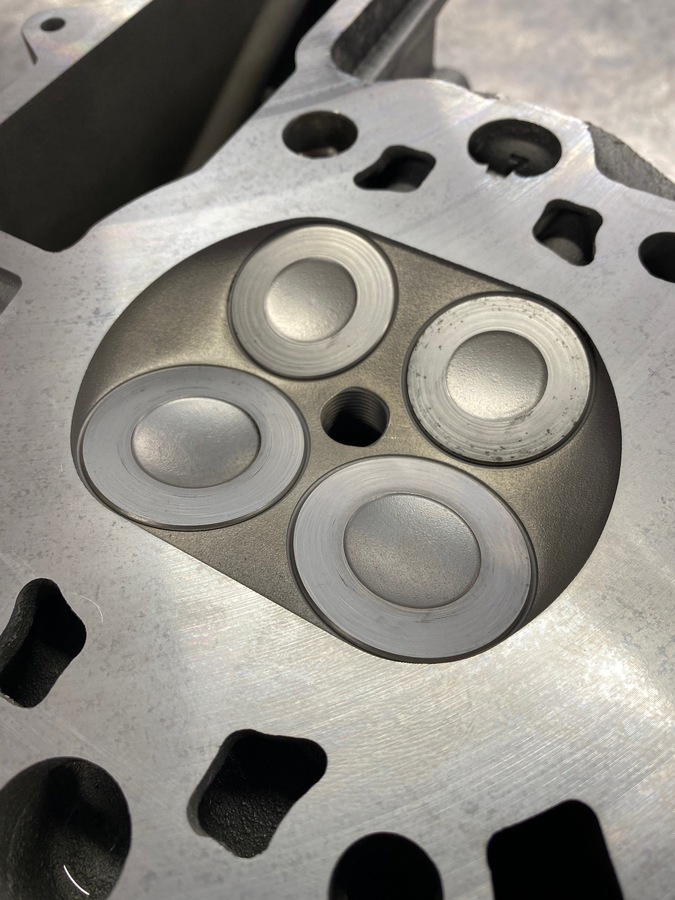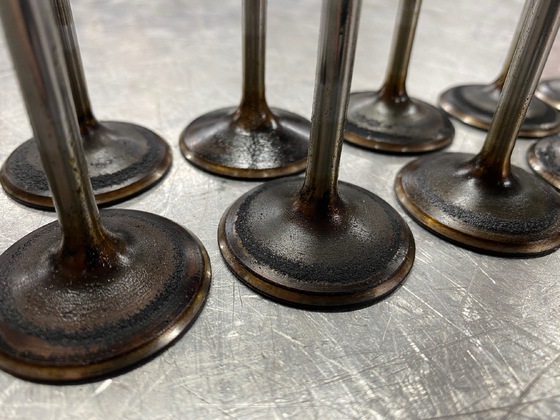
dear all,
anyone who has their engine, gearbox, axles, steering, brakes, whatever, overhauled with us will find that the items look like new when they are delivered back to you from our processing.
Why is that?
Because we want you to get the best possible quality for your good money!
But how does that work?
We have been using a modern shot peening system for a number of years, which is normally used to compress the rotor blades of jet planes to a high degree.
This modern process of surface compression - the forging - of the material we process is now the standard with which we deliver our items to our international customers.
Valves before shot peening
Valves after shot peening:
What exactly is shot peening - what does it mean - how does it work and what is the result of our extensive processing?
Shot peening, or water peening, is a work hardening process used to impart compressive residual stresses to the surface of a component, resulting in altered mechanical properties. The water shot peening process we use increases the strength and load profile of the components we deliver.
In our water shot blasting process, a shot blast (round metal or ceramic particles) is shot at the material surface with precise force in order to create a targeted plastic deformation, a different surface.
When millions of shots hit the surface of the material, with their microfine indentations, they create a pressure layer on the metal surface and envelop the component with just such a different cocoon.
Shot peening methods and media
Our water shot blasting is performed using a high pressure water jet machine. The material bombardment is guided through a nozzle onto the workpiece.
This, our micro-hammer system, ensures that, contrary to the frequently used sandblasting systems, in which unwanted deposits take place in the molecular structure, the medium being bombarded bounces off the workpiece again.
Why do we use shot peening?
The main benefit is to extend the life of the components we machine by creating an induced compressive stress layer through the shelling, thus increasing resistance to fatigue (including corrosion fatigue, stress corrosion and cavitation erosion) while counteracting the development and propagation of cracks.
This generation of compressive stresses that resist metal fatigue helps prevent crack propagation through the material. Stress corrosion cracking is also mitigated internally as plastic deformation supports parts under tension from the inside. Tensile stresses within the materials are not as problematic since surface cracks almost always start on the outside of the materials or components.
Does shot peening increase the hardness of workpieces?
yes, because shot peening is a cold work process, it can increase surface hardness.
Use of shot peening at Albert Motorsport
We now use our surface treatment mainly for the following components:
gear case
transmission shafts
gear wheels
locking differentials
camshafts
valves
feathers
crankshafts
all gears
Pistons
pump
turbine blades
landing gear
probes
stainless steel parts
exhaust systems
etc. ....
The process is used primarily for strain hardening in aircraft repairs. Wherever processes such as grinding can generate tensile stresses, they can be replaced by shot peening and the beneficial compressive stresses. Depending on factors such as shot quality, material, intensity and coverage, shot peening can increase fatigue life by up to 1000%.
But we also use the satin-like sheen of shot peening for cosmetic purposes, creating a marginal, finely forged roughness that scatters light off the surface more effectively than with material-removing processes such as sandblasting.
How much does this shot peening at Albert Motorsport cost extra?
Since we are not dealing with an additional treatment, but a special form of our cleaning processes, the price is always included in the processing of the parts during an engine overhaul.
Reducing issues related to fatigue, stress corrosion or other surface failure mechanisms clearly increases the performance of the parts we machine. This lowers the costs for maintenance and overhauls. In addition, the highly professional surface treatments lead to significantly higher customer satisfaction and a better quality of our craftsmanship.
It is obvious that doing the work of shot peeling is cheaper than failing,
that arises from not having the process done by us, and that's why we do it this way!
If you have any questions about our material - finishing process from
I am at your disposal for engine and transmission parts.
Jürgen Albert
master mechanic
Text: Jürgen Albert
Pictures: Julian Enge




